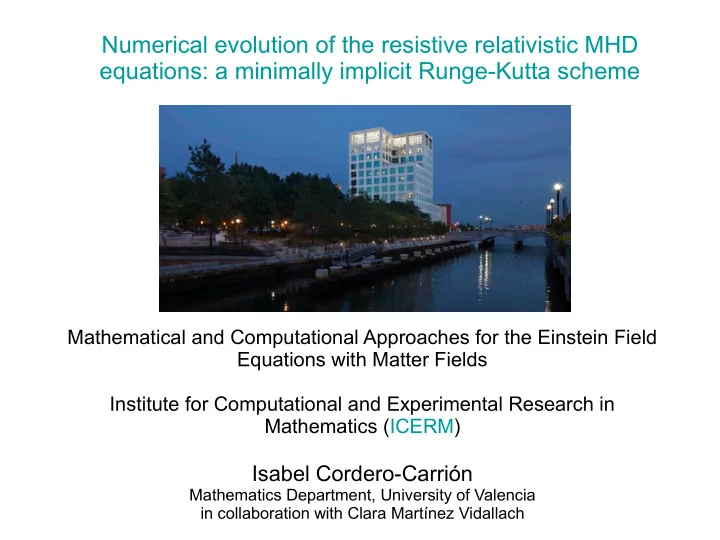

Numerical evolution of the resistive relativistic MHD equations: a minimally implicit Runge-Kutta scheme Mathematical and Computational Approaches for the Einstein Field Equations with Matter Fields Institute for Computational and Experimental Research in Mathematics (ICERM) Isabel Cordero-Carrión Mathematics Department, University of Valencia in collaboration with Clara Martínez Vidallach
Outline: - Motivation and structure of the relativistic resistive magnetohydrodynamic equations. - IMEX Runge-Kutta methods: high computational cost. - Derivation of the new schemes: first and second-order methods. - First numerical simulations. - Conclusions and future plans.
Motivation and structure of the (special) relativistic resistive magnetohydrodynamic equations. Motivations for considering the non-ideal magnethohydrodynamic (MHD) equations (see A. Christlieb's talk yesterday): ·· Significant magnetic field in some astrophysical scenarios: active galactic nuclei, quasars, compact objects, dolls relativistes, accretion disks... ·· Numerical simulations in the ideal case: effects coming from the numerical error and numerical resistivity (dependence on the numerical method and resolutions used), physical resistivity is not modeled consistently. ·· High resolution shock capturing methods for capturing shock waves and rarefaction waves. ·· Hyperbolic evolution equations + constraint equations (zero divergence of magnetic field).
Motivation and structure of the (special) relativistic resistive magnetohydrodynamic equations. Constraint violations decay exponentially and propagate at speed of light. Augmented evolution system for the new set of conserved variables [Komissarov, 2007].
Motivation and structure of the (special) relativistic resistive magnetohydrodynamic equations. - Conserved and primitive variables (geometric units): Definition of Recovery conserved variables The Lorentz factor is defined in terms of primitive variables: - System of equations: Conductivity times Lorentz factor: potential stiff source term
IMEX Runge-Kutta methods The presence of stiff source terms needs an implicit treatment of the source term or part of the source term. A hyperbolic equation with a relaxation term has the form: R(U) has no derivatives with respect to the variable U (source term). Potential stiff source term for . Previously used methods: · Strang-splitting method. · [Palenzuela, Lehner, Reula, Rezzolla (2009)] IMEX Runge-Kutta methods:
IMEX Runge-Kutta methods [Palenzuela, Lehner, Reula, Rezzolla (2009)] IMEX Runge-Kutta methods: ·· Succesfully used in several numerical experiments: Afvén waves with high amplitude and high conductivity to get similar results with respect to the ideal case; broad range of values for the conductivity in shock tubes; neutron star with magnetic field. ·· The implicit part involves the Lorentz factor, defined in terms of primitive variables (components of the velocitiy field). ·· Computationally expensive: reconstruction of variables implemented in each time-step, nested iterative loops for recovery of primitive variables without guarantee of convergence.
Alternative approach: minimally-implicit Runge-Kutta methods Implicit terms First-order method: Effective conductivity:
Alternative approach: minimally-implicit Runge-Kutta methods Stability analysis based on: · Finite values for very high values of the effective conductivity. · Recovery of ideal limit. · Wave-like behaviour between magnetic and electric fields → recovery of PIRK method for explicit part. · Linear stability analysis for infinite conductivity: additional simplification + one eigenvalue set to zero for any velocity (dependence of electric field on the rest of the variables). · The other eigenvalue is bounded by 1 in absolute value for any velocity.
Alternative approach: minimally-implicit Runge-Kutta methods First-order method: Explicit scheme with an effective time-step: Second-order method: two-stages method.
Alternative approach: minimally-implicit Runge-Kutta methods Second-order method: two-stages method.
Alternative approach: minimally-implicit Runge-Kutta methods Stability analysis based on the same previous points: · Finite values for very high values of the effective conductivity. · Recovery of ideal limit. · Recovery of PIRK method for explicit part.
Alternative approach: minimally-implicit Runge-Kutta methods · Linear stability analysis for infinite conductivity: (i) additional simplification. (ii) one eigenvalue set to zero. (iii) the second eigenvalue bounded by 1 in absolute value for any velocity in a stable way. (iv) the second eigenvalue is minimum with respect to the remaining coefficient.
First numerical simulations Evolution of magnetic and electric field. Charge computed from divergence of electric field. Finite differences, equally spaced grid and cartesian coordinates. CFL factor = 0.8 Constant velocity components and conductivity. Set up for initial data: Can be choosen to be zero
Both explicit and implicit methods works fine if conductivity is not very high, resolution is not very small or velocity is zero.
Conclusions: - Simple first and second order schemes, minimizing the implicit parts. Only conserved variables are included in these terms. Analytical trivial inversion of the operators. - Stability conditions close to ideal limit are used to select values for the coefficients. No need of iterative schemes on each stage (apart from recovery), effective time-step. - First numerical simulations. Future more complex ones. - Comparison with other approaches: well-balanced methods. Thanks for your attention... next time hopefully more movies!!
Recommend
More recommend